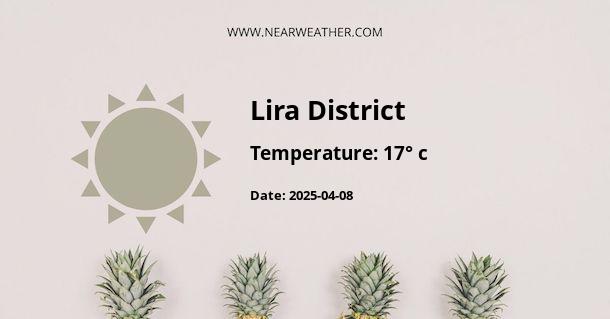Lira District, Uganda: Climate and Weather Year Round
Lira District is located in northern Uganda, and it is known for its diverse climate and weather patterns throughout the year. The district experiences two main seasons, the dry season and the wet season, which greatly influence the local environment and agricultural activities.
Temperature
The average annual temperature in Lira District ranges from 20 to 30 degrees Celsius. However, the temperature can vary significantly between the dry and wet seasons. During the dry season, which typically occurs from December to February, temperatures can reach as high as 35 degrees Celsius, making it quite hot and arid. On the other hand, during the wet season, which usually falls between May and September, temperatures tend to be cooler, ranging from 20 to 25 degrees Celsius.
It is important to note that Lira District experiences a semi-arid climate, which means that the region receives relatively low rainfall throughout the year. This has a direct impact on the temperature and overall weather patterns in the area.
Rainfall
The rainfall in Lira District is highly variable, with an average annual precipitation of about 900 to 1,200 millimeters. The wet season is characterized by heavy rainfall, often accompanied by thunderstorms and occasional hailstorms. During this period, the district receives the majority of its annual rainfall, with the peak occurring in August. On the other hand, the dry season experiences minimal rainfall, with little to no precipitation.
The distribution of rainfall within the district is not uniform, with some areas receiving more rainfall than others. This can have significant implications for agriculture and water availability in the region.
Humidity
Due to its semi-arid climate, Lira District experiences relatively low humidity levels throughout the year. During the dry season, humidity levels can drop significantly, making the air feel dry and arid. However, during the wet season, humidity levels tend to increase, creating a more humid environment.
Wind Patterns
Lira District experiences moderate wind patterns throughout the year. During the dry season, winds tend to be stronger and can contribute to the arid conditions in the region. These dry winds can also lead to increased evaporation rates and further drying of the soil. In contrast, during the wet season, winds are usually calmer, allowing for the proper distribution of rainfall.
Agricultural Implications
The climate and weather patterns in Lira District play a crucial role in agricultural activities. The dry season poses challenges for farmers, as water scarcity becomes a major concern. Irrigation systems are often utilized to ensure the successful growth of crops during this period. On the other hand, the wet season is ideal for farming, as the rainfall provides the necessary moisture for crop growth and development.
The district primarily relies on rain-fed agriculture, with staple crops such as maize, millet, sorghum, and groundnuts being cultivated. The timing and distribution of rainfall are critical for the success of these crops, and farmers closely monitor weather patterns to plan their planting and harvesting activities.
Conclusion
Lira District, Uganda, experiences a semi-arid climate with distinct dry and wet seasons. The temperatures range from 20 to 30 degrees Celsius, with the dry season being hotter than the wet season. Rainfall is variable, with the wet season receiving the majority of the annual precipitation. The district's climate and weather patterns have significant implications for agriculture, with water scarcity being a major concern during the dry season. Farmers rely on rain-fed agriculture and closely monitor weather patterns to plan their farming activities.
A - Lira District's Latitude is 2.331070 & Longitude is 32.945869.
A - Weather in Lira District is 20° today.
A - Climate Conditions in Lira District shows light rain today.
A - Humidity in Lira District is 90% today.
A - Wind speed in Lira District is 5.04 km/h, flowing at 117° wind direction. today.
